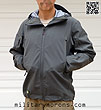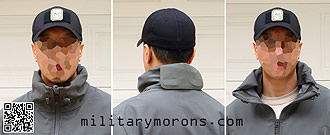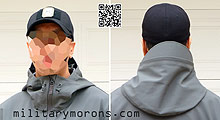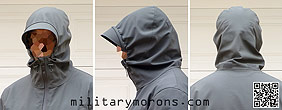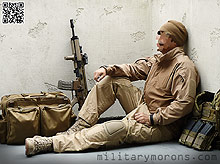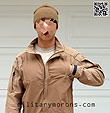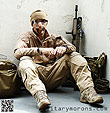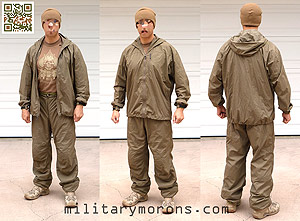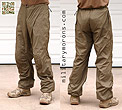Non-Insulated Soft Shells Page
1 Page 2 Page 3
Page 4
As a sizing reference: I'm 5'7", 155 lbs (yeah, I'm a little guy), medium build (BDU top medium/regular, BDU pant medium/short), waist 32", chest 43". Keep this in mind when you read my comments with respect to sizing, so you have an idea of how the garments featured below will fit on you. ALL garments in these pages are size Medium, unless stated otherwise.
TO VIEW FULL SIZE IMAGES: USERNAME and PASSWORD are both "mm"
| 7/4/11 - For 2011, the new Stealth Hoodie LT from Triple Aught Design (TAD) incorporates a completely new textile composition to make it one of TAD's most versatile Stealths yet. It is a three-layer system custom-engineered with Swiss-made Schoeller® textiles and treatments. The 'LT' designation indicates that it is an uninsulated version of the Stealth; suitable for stand-alone use in warmer weather.
The last Stealth Hoodie version I reviewed was the Stealth Hoodie Reloaded in 2009. The Stealth Hoodie LT is very close to the Reloaded in design and features, with the main difference being that it's uninsulated vs. insulated, with a brand new advanced fabric. The LT shares many features with it's predecessor, such as colour-matched components, less seams for better water resistance, reinforced elbows and welded areas. Material and treatments - The material used on the new LT is from Schoeller® in Switzerland. Externally, it's virtually identical to the fabric used on the Gen 1 Stealth Hoodie, reviewed five years ago. It's not surprising, as the Gen 1 was made of WB-400 from Schoeller. That's where the similarity ends. The most noticeable difference is that the LT fabric is uninsulated, whereas the WB-400 was backed with Polartec fleece. The material used on the LT is Schoeller's three-layer, four-way stretch, 240gm/m² system, which is made up of the abrasion-resistant face fabric (73% nylon, 21% urethane, 73% nylon), a wind/waterproof membrane called c_change™ (92% nylon, 8% elastane), and a smooth tricot backing (100% polyester). The heart of the system is the c_change™ membrane: c_change™ - c_change™ is a Schoeller® technology, and is a wind and waterproof membrane that independently reacts to changing temperatures and activity. When I first looked it up, and saw that it was referred to as a 'bionic climate membrane', I'll be honest - I thought to myself "Bionic? what kind of bullshit marketing hype is this? Who's making this up?" When I saw that it was a Schoeller technology, that immediately restored credibility back to the claim, as Schoeller is an established leader in the high-performance textiles market. According to the manufacturer, the c_change™ membrane is based on an example from nature - the fir cone. Fir cone scales open and close in response to different weather conditions; the female pine cone opens when warm and dry (more favourable conditions for seed dispersal and germination), and closes when cold and wet. The c_change™ polymer membrane reacts to different conditions like a pine cone; at high temperature of during aerobic activity, the structure of the c_change™ membrane opens as body moisture levers rise so that excess heat and moisture can escape. In colder weather or inactive periods, with lower levels of body moisture production, the structure of the c_change™ membrane contracts, which helps retain the heat close to the body, preventing chilling. The c_change™ membrane is both wind and waterproof. The test results for the non-laminated c_change™ are impressive. Water resistance is 20,000mm and breathability (MVTR) is 18,000 g/m²/24h, Ret value is < 2. A Ret (ISO-1092/Hohenstein test) value from 0-6 indicates that the membrane is very good or extremely breathable, which translates to comfort at higher activity rate. Besides the membrane, the Stealth LT makes use of two other technologies to further enhance its performance: 3XDry® - Another Schoeller® technology, 3XDry® is a moisture management treatment that makes textiles water and stain repellant on the outside and water absorbant on the inside. The outside of the textile is finished with a water repellant treatment (hydrophobic), and the inside of the textile has a hydrophilic finish to absorb perspiration. Garments finished with 3XDry® keep the body drier and more comfortable by absorbing perspiration from the inner side of the textile and transporting it away from the body to the outside, where it's distributed over a large surface area to dry faster. Both the face fabric and tricot backing on the Stealth LT are treated with 3XDry®, which creates a system that repels water, dirt and stains on the surface while absorbing moisture and perspiration on the inside. The treatment does not affect the appearance, hand or air permeability features of the fabric. coldblack® - Yet another Schoeller technology, coldblack is a new textile technology which was launched in summer 2008 by Schoeller and Clariant International AG. Clariant is a global leader in the field of specialty chemicals. Schoeller is responsible for the sales, marketing, branding and patenting of coldblack; while Clariant is responsible for the sale of chemicals, technical support and quality control for the coldblack finish. coldblack® is a proprietary chemical finish for textiles that are exposed to direct sunlight over a long period of time. It is fully wash resistant and will not wash out. coldblack® prevents textiles from heating up as much and offers protection against UV rays. In other words, coldblack® is a sun reflector+ UV protector. In general, dark coloured textiles absorb both visible and UV rays of sunlight, heating up more than light coloured textiles, that reflect both light and heat. coldblack® reduces absorption of heat rays, particularly in darker colours, and in all treated textiles, resulting in better heat management. Black textiles can absorb up to 90% of the heat rays when exposed to direct sunlight, and heat up accordingly. When treated with coldblack®, textiles reflect up to 80% of the heat rays and stay noticeably cooler. Test performed in the lab showed that a black coldblack® shirt stayed approximately 9° F cooler than a non-treated shirt when exposed to simulated sunlight. Tests also showed that users sweated half as much when wearing a black shirt with coldblack® technology vs. a conventional black shirt during activity. Besides garments, coldblack® technology has been applied to automotive seat covers, sun shade/awnings, and tents, keeping those items cooler when exposed to direct sunlight. The Stealth LT face fabric is dyed in a process that incorporates the coldblack® treatment, which reduces overheating of fabric in the sun. It not only helps keep the wearer cooler by reflecting UV rays, it also prevents the garment from fading due to sun exposure. Of the different verisons of the Stealth Hoodie, the Stealth LT is most similar in external feel to the Gen 1 Stealth Hoodie but thinner, of course (without the insulation). As far as weight goes, the material feels more substantial than the SharkSkin v3.0/Gen 3 Stealth Hoodie, which was more light weight and thin. It's also quite packable and foldable, fitting inside a backpack compartment without a problem. The Stealth LT is available in Black, ME Green, and UE Grey (pictured here). The UE Grey is a medium grey, and the photos below show the colour pretty accurately. In some of the photos, it looks a little blue, but that's because of the overcast daylight, which shed a bluish tinge on everything.
For those familiar with the previous generations/versions of the Stealth Hoodie, the Stealth LT retains the familiar Stealth Hoodie silhouette. It's available with or without (shown here) velcro patches on the shoulders.
Here's a summary of the features on the Stealth Hoodie LT, 2011 model:
Observations/Notes - If I had to be brief, I'd characterize the Stealth LT to be an uninsulated version of the Stealth Reloaded. It can be used for a wider range of temperatures, as it's designed for layering over insulated garments, and by itself can be used in warmer temperatures than the Reloaded. Like the Reloaded, all components are colour-matched for monochromatic uniformity. Actually, even more so as the Reloaded had black die cut cuff tabs. The welded reinforcements, zippers, shock cord, cord locks, velcro, zipper web pulls, are all very closely matched in colour. All the pockets are common to the previous Stealth hoodie models, so the layout should be familiar to those who have owned them. As mentioned above, the Stealth LT fabric is more substantial than the thinner Shark Skin material used on the v3.0, but more supple and thinner than the insulated fabric used on the Reloaded. It folds up pretty compactly and I can stuff it into a backpack without it taking up much room. Like on the Reloaded, the welded elbow reinforcements really add to the feel of durability of the garment. They provide both abrasion resistance and some protection from hard surfaces in the prone position. The fit of the LT definitely feels more roomy than that of the Reloaded. The Reloaded wasn't snug on me, but there wasn't much excess space either. I was able to wear a form-fitting mid-weight mid layer underneath the Reloaded, but nothing much thicker as it'd be tight under the arms. The Reloaded was designed more as a stand-alone jacket, after all. The LT on the other hand, with layering as part of its intent, is sized as such. I was able to don it over a Ranger Hoodie, which is a thick fleece garment (form fitting, however). That's about as bulky as I'd go, as it's snug, but not too tight. It easily fits over a regular heavy sweatshirt on me, without feeling too tight under the arms (as in the Reloaded), and works well with other mid layers I tried it over. If I were to wear it over any insulative layers, I'd pick the more form fitting ones to minimize excess bulk under the jacket.
So, I'm sure the question on everyone's mind is 'so well does this new high-tech fabric work? The first thing I always do is test the water resistance. While a new DWR-treated garment will usually shed water more readily than a worn, dirty garment, I've seen brand new soft shell fabrics let water through quite quickly. Since I always perform the test first on a brand new garment, my basis of comparison is the same for them all. It simply consists of lining the sink with the garment, finding an area of fabric with no seams, and filling the area up with water; letting it sit and checking on it periodically. I'll also start rubbing the area under water if I still don't see any penetration after a couple of hours, to simulate water being rubbed into the face fabric from contact with backpack shoulder straps etc. As expected, the Stealth LT fabric is waterproof. I left it in the sink for a full 12 hours (left it in the morning, and checked it during the day), and nothing made it through. The face fabric beaded up any water, and barely showed any signs of saturation, even after that length of time.Like the Reloaded, the LT fabric is pretty much approaching hardshell performance when it comes to water resistance, and moisture penetration is going to be limited to the unsealed seams and zippers (which are not the water proof type). The fabric is also wind proof, as blown air under pressure doesn't make it through to the inside. While the Reloaded is one of the most breathable insulated soft shell jackets I've tried, it's more suited to cooler weather. The Stealth LT is probably the first soft shell I've tried that can actually be used in warmer weather (not hot weather) under certain conditions. I have other garments made of uninsulated Tweave that also feel pretty breathable in warm weather, but Tweave is water resistant, not water proof. I had some varied spring weather to take advantage of the Stealth LT, ranging from cool (upper 50's) to warm (70's). We had some medium rain/drizzle, which the LT handled without issue. I'd have been surprised if it didn't. Walking around without exertion on cooler days in the 50's (mostly in the mornings and evenings), with the wind blowing, the LT doesn't offer much warmth by itself with only a t-shirt underneath, as it's uninsulated. I wasn't warm and cozy, but I wasn't cold either. Once I started moving a bit more, with a little exertion, I warmed up comfortably pretty quickly, but didn't feel stuffy. The LT fabric feels very durable and abrasion resistant, and doesn't make one feel concerned about wear. The elbow reinforcement really adds to the durable feel of the garment. I intentionally wore the LT on warmer days, when a jacket really wasn't needed, and was surprised that I didn't feel too hot in it. Even in my car on a warm day, I still felt comfortable. Note that I wasn't exerting in the warmer weather, as I just wanted to see if it got stuffy, just sitting there. I tried it out when the temperature was in the upper 60's (it was actually t-shirt weather), and did a little more exerting. As I expected, I did start to feel some stuffiness, mostly in the sleeves and back. Note that I'd have felt too warm in just about any long-sleeved garment, even a cotton shirt, under those circumstances. Compared to other uninsulated garments of similar weight made from Tweave of the same thickness, the LT felt more breathable. The bottom line is that it's difficult to state usable temperature ranges, as they're so dependant on whether the user is sedentary or exerting, and the ambient conditions. You can feel hot in a t-shirt in cold weather if you're working hard enough. I'd estimate that the upper limit for the LT is about 70-72° when stationary/not exerting, and about 60°-65° when moving (slow hike). The lower limit depends on what you're wearing underneath, and the LT then serves as a wind/rain shell in cold weather, depending on the mid layer for warmth. I sometimes get emails from readers asking which soft shell is suitable for warm/hot and humid climates. I'm not sure, really - the LT is the closest thing so far to a warm weather soft shell, but I don't think I'd find anything comfortable in humid climates. I lived in the tropics for about 10 years, and it basically sucked. I was sticky all the time. Nothing worked as well as an umbrella, if I wanted to stay dry. The other experience I've had with coldblack® is with a black polo shirt from VERTX, and the different between an untreated garment and treated one is hard to quantify, unless they're very dark. The coldblack® doesn't make a dark garment feel cooler than a light one; it makes a dark one feel cooler than other untreated dark ones, or as cool as a lighter coloured garment. I did notice that in the sun, my NYCO pants felt warmer to the touch than the LT fabric, and my thighs felt warmer than my arms. Whether that has anything to do with coldblack®, I don't know. The Reloaded was the most breathable insulated, fleece-lined soft shell I had tried, and the Stealth LT seems to be the most breathable uninsulated soft shell thus far, and a true 3-season jacket (at least for my neck of the woods). Garment performance has to be taken in context with purpose - it's unrealistic to expect a jacket to feel just as airy as a t-shirt under the same conditions. But with advances in fabric and treatment technology, windproof/waterproof garments are getting much more usable over a wider range of conditions than they were in the past. With each new model, TAD utilizes and incorporates the latest in textile technology into their garments, producing a practical garment that performs as well as it looks, around town or in the field.
|
Massif Integrated Tactical Jacket
| 7/20/11 - The Integrated Tactical Jacket from Massif is their first non-FR piece of clothing, with more to come. The ITJ is a light weight, water-resistant, dual-fabric, non-FR top designed for compatibility with armour in cool or inclement weather. The ITJ is available in Black, OD Green and Tan, but for its initial offering, the Tan version is only available exclusively from U.S. Cavalry.
I first reviewed Massif gear back in 2007; all of it being FR (Fire Resistant). Massif (also referred to as Massif Mountain Gear Company) is located in Ashland, Oregon. Massif's founder Randy Benham (a search-and-rescue professional, and before that having 15 years of experience making custom outerwear and climbing equipment) started to design and build clothing and equipment out of necessity for his Rescue team when he found that available products were unsatisfactory. As word spread, Randy founded Massif Mountain Gear Company to keep up with the demand for his custom made equipment and clothing. Massif now distributes its products to rescue professionals, fire teams, ski patrols, law enforcement, the military and government, and private companies. While Massif has built its reputation on FR gear, their understanding of the end users' needs and experience when it comes to tactical clothing design translates well into the non-FR garment arena. It makes perfect sense that they've started their own non-FR line (starting with the ITJ) to provide gear to customers who like Massif's designs and high performance fabrics, but don't need FR protection. The ITJ is designed as an inclement weather jacket to be worn under armour. It uses a more weather resistant softshell fabric on the yoke, shoulders and tops of the sleeves, which are the more exposed areas, and a lighter weight fabric on the torso for comfort and reduced bulk under armour. We've seen similar garments in the Arc'teryx LEAF Combat Jacket and Sphinx Halfshell (which also uses two types of softshell fabric), which are basically inclement-weather replacements for a BDU jacket. The ITJ is designed with the same usage in mind, but with differences in the execution. Material - The ITJ uses two different stretch-woven fabrics in its construction. The sleeves and yoke feature a stretchy, 6.5 oz, 86% nylon/14% spandex fabric with DWR (Durable Water Repellant) finish for water resistance and wind protection. It's a completely matte finish, smooth-face fabric. The texture is similar to Schoeller WB400 on the outside, and not as rough as Tweave. Inside, the fabric is lined with a very soft, almost terry-cloth-like texture, only with very low nap. I wouldn't call it insulation, but more of a wicking lining for comfort and dryness. I did my water-resistance sink test on the fabric and it's quite water resistant. Water beads up on the surface, and it'll hold a pool of water for quite some time before the water eventually makes it through the DWR. Even so, it takes a bit of rubbing and coaxing to get more water to soak through. The jacket is meant as a water-resistant jacket, not a water proof one, and it should work well in drizzle, light showers to medium rain. If it's raining hard, the pressure from heavy raindrops can eventually cause it to wet out, and a hard shell might be needed instead. The torso and under arms use a 89% nylon/11% spandex 5.5 oz fabric for breathability and quick drying. It's also DWR treated. On the tan jacket shown here, the 5.5 oz fabric is slightly darker than the 6.5 oz fabric, hence the 'two-tone' description that Massif uses. The contrast really isn't that much. The 5.5 oz fabric is also very stretchy and breathable, and has a very fine grid pattern lining, also intended to wick away moisture from the skin. Water will bead up on the DWR but pressure will force the water through (like heavy rain drops). That's why the more water-resistant fabric is used on the exposed areas. The torso fabric is thin enough to wear it tucked into pants, or out. The ITJ is available in Black, 2-tone OD Green, and 2-tone Tan (pictured here). For the initial offering, the Tan version is only available exclusively from U.S. Cavalry.
Here's a summary of the features on the Integrated Tactical Jacket, size Medium shown:
Observations/Notes - My intial impression of the Integrated Tactical Jacket concept is that it's role is similar to that of the Arc'teryx Sphinx, and the Otte Gear DK Hybrid, which are also designed to be worn under body armour. The Sphinx is a pullover design though, while the DK hybrid is a full zip. Rather than wearing a BDU coat/shirt, with a shell over it, these jackets are intended to replace the BDU shirt. The advantage to wearing a jacket like the ITJ instead of a BDU and shell is that you don't have to take your armour on and off to put the shell over the BDU top when the weather starts getting wet. The ITJ is more breathable than a hard shell jacket or full soft shell, with its breathable torso and underarm fabric, so there's less need to take garments on and off to accommodate changes in the weather that might include cool weather, some rain, then later warm up a bit. I also noticed that the ITJ fabric is pretty quiet, and has a lower pitch 'swish' sound than most other nylons. The comfort range of inclement-weather BDU replacements will depend on the amount of physical activity the user is engaged in. You'll feel quite comfortable sitting around in 70° weather and armour over the ITJ, but if you start moving, it might start getting a bit warm. Most of these types of garments are best suited to cooler weather, I've found; preferably below 65° if you intend on doing anything physical. Pit zips and vents (the mesh inside the pockets in the case of the ITJ) do help regulate the temperature inside the jacket.
The high collar is actually made of two layers - the 6.5 oz on the outside, and lined with the 5.5 oz on the inside. It's very comfortable and the double layer protects well against chafing from a rifle sling. I really like the extra little design touches like the covered main zipper and protected sleeve pocket zippers. When I first tried the ITJ under the Crye JPC, I initially thought that the dual storm flaps over the main zipper might feel uncomfortable under a front plate to to a bit of added thickness, but that wasn't the case. I can feel it there, but it's soft; not a hard little bump like a BDU button. I did notice that the ITJ doesn't have as many stitches per inch as some other manufacturers; but since all the seams are double-stitched, I don't really have any concerns about it. As a stand-alone jacket, the only thing the ITJ lacks are side-entry hand warmer pockets down at the bottom, like most garments designed to be worn primarily under armour. But adding those would detract from its primary mission as an under-armour garment, and add unnecessary bulk to the torso in that role. I found that the ITJ is cut short enough that I can put my hands in my pants pockets if I choose, without having to hike up the bottom hem too much. Walking around with only a T-shirt underneath the ITJ in the low 60's proved to be quite comfortable, with the occasional cold gust of wind feeling a bit chilly on the thin torso. For the mid 60's to low 70's, the ITJ makes a really nice windbreaker/light jacket for the cooler mornings and evenings. While the ITJ is designed primarily for the LE/Military market, I think it fits just as well in the civilian/outdoor market. With the reduced bulk of the torso, it makes for a more packable jacket that can be folded and stored in a backpack compartment. I also found that the ITJ (along with other 'combat' tops that have thinner fabric for their torsos) works well with a pack in colder weather. The low profile torso doesn't add bulk under a pack hip belt. I have a backpack-style child carrier (not a baby carrier), in which I take my 3-1/2 year old son around on my back in the evenings around the neighbourhood after dinner. It's usually cool by then, and can be downright chilly. With a sweatshirt or regular jacket, my body can often get too warm once I start going on a brisk walk up and down rolling hills, while the wind chills my extremities. With the ITJ, my arms keep warm while the more breathable torso and underarm fabric helps prevent me from getting too hot under the collar. If you're familiar with Massif's FR garments, you'll know that they're well designed, quality pieces. I was surprised at the price of the ITJ, though. It's lower than one would expect for a soft shell jacket made in the USA and priced very competitively.
|
Arc'teryx LEAF Wraith Jacket and Pants
| 10/9/11 - The Wraith Jacket and Wraith Pant from Arc'teryx LEAF are extremely lightweight and compressible garments; intended as emergency layers that fit over combat clothing and low profile gear to accommodate unexpected changes in the weather or unforseen circumstances.
The Wraith Jacket and Pant are similar to the SOF-PCU Level 4 Windshirt in intention; providing the user with a very lightweight and packable wind/water resistant garment for unexpected changes in weather. Only they do so in a better package than the SOF-PCU L4 item. Many manufacturers offer light weight windshirts, but few offer a complete set. I asked JF from Arc'teryx LEAF to give me a bit more insight into the Wraith garments, and he said that the Wraiths are not intended as a waterproof layer; rather they are wind/water resistant pieces for increasing the margin of safety/comfort when moving fast and light. A recurring story he kept hearing (from the intended customer base) was that of being sent on 4-hour mission in fair weather and it turning into 12-24 hours in sand storms or wet sleet waiting for the birds or due to some other delay. The Wraiths obviously aren't ideal for all conditions but they beat lying on a rooftop around in your nylon/cotton or FR uniform when the weather turns. The Wraith Jacket was designed to layer over very light plate carriers (Crye JPC, Mayflower Low Profile Carrier, LBT-1961A, Tyr Pico ect.) and/or minimalist chest rigs. Depending on the user's build and loadout, it might fit over a CIRAS or similar rig, but this was not the design intent. Material - The Wraith Jacket and Pants are made of Gossamera™ - a 100% Nylon ripstop fabric with durable water repellant (DWR) coating: it's the same textile as the Atom AF jacket face fabric. Technically, it's a mechanical stretch 30 denier false twist nylon 66 (not a cheap nylon 6 or polyester) with an extremely light PU "kiss coat" that improves the water and wind resistance. The Wraiths are available in Crocodile for mixed landscapes and Overwhite for snow and ice. The Overwhite is translucent so that any camo pattern or colour of the underlying clothing is faintly visible through it. This gives it a wider range of environments than standard opaque overwhites. The first thing I did (as I do with all water-resistant garments) was to line the sink with the Wraith jacket and fill it to a depth of about two inches, just to see how water resistant the fabric is. I was actually surprised by how long it took for the water to wet the fabric through to the back side - more than half an hour. Note that this is standing water with pressure. Water just poured on the fabric just runs off, due to the water repellant coating. For such a lightweight fabric, it's very water resistant. It's also quick drying, due to its thinness.
Wraith Jacket - Here's a summary of the features on the Wraith Jacket, size Medium shown:
Wraith Pants - Here's a summary of the features on the Wraith Pant, size Medium shown:
Observations/Notes - As mentioned above, the Wraith Jacket and Pants are designed primarily as an emergency layer that's light enough to carry on your kit or gear, when a heavier or more bulky garment cannot be accommodated. It's not intended to replace a Goretex shell. When extended exposure to inclement weather or colder temperatures are expected, then it might be more sensible to wear garments like the Alpha LT series, Gryphon or Sphinx which are designed for that type of weather. The Wraiths are brought along when the unexpected happens - a daytime mission lasts longer than expected and desert temps fall at night; the weather takes an unexpected turn for the worse etc. My first impression of the Wraiths is that they're very light, and about as packable as any similar item I've seen. The Wraith jacket is even lighter than Marmot's DriClime Windshirt, which doesn't have a hood. The jacket's stow pocket is oversized; the jacket packs relatively loosely in it. The pant stow pocket packs it a bit tighter. The jacket's stow pocket is large enough to pack BOTH the jacket and pants (which is why it's oversized), into a relatively compact package, which can be compressed even further. I've illlustrated them below, with a USGI 1-qt canteen for size comparison. With the jacket/pant combination weighing less than 12 oz, it's a small weight price to pay for the advantages of having them if you need them. Either one alone will fit in a BDU pant cargo pocket.
The material used on the Wraiths has 'mechanical stretch' properties; relying on the way it's woven, rather than the addition of spandex or other stretch fiber. The additional stretch makes the Wraith very unrestrictive. Arc'teryx draws its clothing design experience largely from the climbing/mountaineering arena, and know how to design clothing that allow full range of motion and mobility. The material is breathable, yet very wind-resistant. My usual, non-tactical use of wind shirts is for motorcycle riding. I ride the motorcycle to work a few times a week. In the winter, I wear a leather jacket with something like the Atom LT underneath it. During the summer months, it's still cold in the morning, but warms up and gets hot in the afternoons. During the warmer months, I wear a mesh jacket with a thin wind shirt underneath it, which I stow for the ride home. I usually wear the Artkis Stowaway shirt, but swapped it out with the Wraith this summer. Riding a motorcycle with a mesh jacket is a convenient method for me to test the wind-resistant properties of any windshirt or jacket, as I'm riding in chilly morning air at 50 mph. The Wraith jacket performed very well, in spite of the thin material, stopping all the wind and keeping me quite comfortable. Even though the Wraith jacket is slightly oversized in the torso, it adds virtually no bulk, even when worn under the mesh jacket. The one small issue I had with the Wraith pant was that the waist elastic was a bit tight. The elastic was shorter than the actual pant waist, so that it was 'pre-cinched up'. Or maybe I'm just getting fatter. So, I cut myself a longer length of elastic shock cord that was basically the circumference of the pant waist when fully relaxed, and replaced the shock cord. Much better for me. The tall side zippers on the pants enable side slash pockets as well as thigh cargo pockets on pants to be accessed. In fact, they open up enough to allow you to reach your fly so you can take a piss, which is handy since the Wraith pants have no fly opening of their own. They also work very well as vents. On some of the chillier morning motorcycle rides, I wore the Wraith pants over my regular pants (like VERTX). I was able to don and doff them while wearing boots. Like the jacket, the pants helped keep the chill out by stopping the wind from blasting through my pants fabric. While the LEAF line is designed primarily for military and law enforcement users (and some specifically for tier 1 military units), I think that the Wraith jacket and pant are light and compact enough to be carried along on day hikes or as part of a survival kit. Quite often, we see stories of lost or injured hikers on the news, who would have benefited greatly from the protection afforded by a slip-over jacket and pant. As mentioned before, the Wraiths are not waterproof, but can prevent or delay the absorption of moisture (depending on the conditions) into the user's garments, keeping them drier. The wind resistant material also increases the insulation efficiency of any non wind-resistant insulating layer (like a sweatshirt or sweater), reducing heat loss. Instead of protection in cold weather, the Wraiths might be suitable for warmer climates as well, when a heavier/thicker rain jacket may be too warm, and a lighter jacket is desired for protection from quick showers or drizzle. I think they also make the perfect set for the traveler who likes to pack light, or the motorcycle commuter that might encounter inclement weather. Anyways, whether you're in a Tier 1 unit or a regular Joe civvie like me, I'm positive that you'll be able to put the Wraith jacket and pant to good use.
|
ATTENTION! PLEASE DO NOT LINK DIRECTLY TO MY IMAGES
-
IT RESULTS IN MY BANDWIDTH ALLOCATIONS BEING EXCEEDED,
AND MY PAGES GO DOWN. THANKS!
/ . PLEASE
OBSERVE AND RESPECT OUR COPYRIGHT! . /
©opyright by MilitaryMorons.com. All Rights Reserved. Reproduction, Duplication,
Distribution Strictly Prohibited.
Unless mentioned otherwise, content and images are the
property of militarymorons.com and are not in the public domain.
They are not to be used without
permission. Please Contact
me for permission to use any images or content herein.



